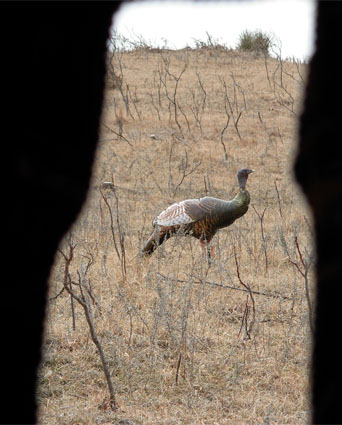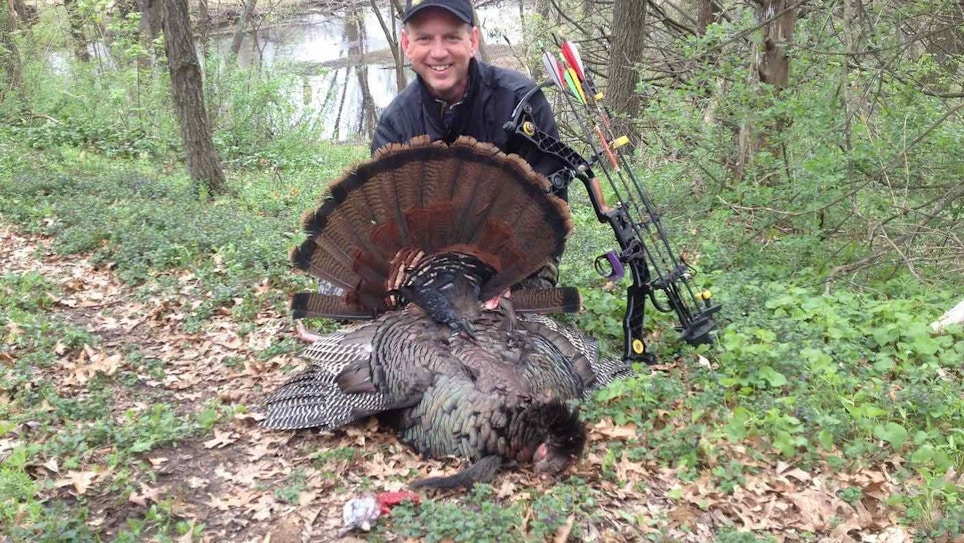 Conceal Your Blind
Conceal Your Blind
There is a sickening feeling when the tom you worked hard to bring in suddenly flares off and skirts your setup. The best prevention? Doctor up your blind! By "doctor," I mean thoroughly brush in your blind as if you were hiding it from a thief. First, look for a spot with a good solid background and plenty of cover. Try to keep the sun behind you. Next, move back into cover, into the shadows. Cut out an area no larger than your blind. Squeeze your blind in the cleared area. Cover exposed areas with additional foliage placed to look natural, and don’t leave any freshly cut ends exposed. Be sure to break up the blind’s outline. Finally, cut several shooting lanes. Once finished, only the shooting ports should be visible.
Eliminate the Blind's Black Holes
Open shooting ports in pop-up blinds create black holes, which spook educated gobblers. Eliminate black holes by leaving the shooting ports closed until the shot. If the gobbler is alone and locks up on the decoys, you should be able to open the window with little trouble. Of course, this assumes the blind has a silent system for opening/closing window coverings. If the tom takes a quick glance at the decoys and keeps on moving, or there is more than one bird, you might have a problem.
You can cover black holes with shoot-through netting, which offers maximum concealment. The drawback is reduced visibility, especially during low light and rain, and it limits your choice of broadheads. You can also have problems when the sun is high above the trees. If the sun’s rays strike the netting, it can create an intense glare.
My favorite way to eliminate black holes is to use a blind with a non-black interior. This is blasphemy in certain circles, but, believe me, it works. And, instead of black, I can wear regular camo, which is a plus when coming or going from my blind, or when I’m using aggressive run-and-gun tactics.
Add Movement to Turkey Decoys
Movement brings the decoys to life. Moving decoys offer personality and emotion that stationary decoys don’t.
The are two main types: those triggered by wind and those activated by a pull string. I prefer the wind-activated decoys because they are simpler to use, take less time to set up, and it’s normally windy in springtime. I prefer inflatable decoys like those made by Cherokee Sports. They come with a two-size stake system. Using the small end allows the decoy to spin in the slightest breeze. Using the larger end creates friction when the wind is heavy. When deflated, these lightweight decoys will fit in a coat pocket for easy carrying.
When the wind is calm, you may need a string to initiate movement. A little time, effort, ingenuity, and string can turn your favorite fake into a spinning, sliding, squatting, flopping, gobbler-fooling apparatus.
Don't Call to Call-Shy Toms
Call-shy toms can be some of the more difficult of the educated turkeys to take. They are reluctant to respond to calls and, in extreme cases, avoid them altogether. First you need to diagnose their shyness level, then adjust your calling accordingly.
I remember one particular tom that would not leave the tree if he were called. He stayed up until mid morning. The hunter who finally killed him did so by leaving his calls at camp. Another public land tom I encountered wasn’t entirely call-shy, but was turned off by a particular type of call. I switched to soft calling and scratching in the leaves, and he slowly worked his way into easy bow range.
One of the most difficult gobblers was an old tom that lived on land leased to an outfitter who operated a low-cost/high-volume, archery-only service. At the sound of my calls he would charge in, gobbling every step of the way, but would always hang up a teasing distance away. On one occasion I thought I had him when a hen came in and mingled with my decoys, but he stood his ground, intercepting her only when she had moved a safe distance away. After four days of this, his gobbles started to sound like chuckles of laughter.
Finally, on the evening before the last morning’s hunt, I roosted him off the end of a small meadow, just inside the timber. Once it was nearly dark, I eased down and set up in a clump of oaks about 20 yards from the end of the meadow. Rather than setting up the decoys on the side of my blind facing the gobbler, I set them up behind it, well out into the meadow and nearly out of bow range. The next morning I waited silently in my blind. He eventually pitched down from the roost, landed just inside the timber, and walked out right in front of me. As he looked at the decoys, I put an arrow just above his beard and ended his mischief.
His long sharp spurs told the story of a gobbler that for a minimum of five years had eluded dozens, possibly even hundreds of other bowhunters. There is an overwhelming sense of accomplishment when you take a gobbler of this nature . . . a feeling you might experience only if you adopt tactics for bowhunting educated toms.






